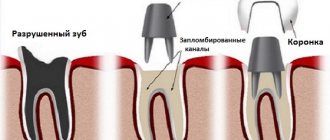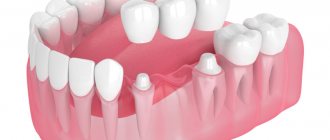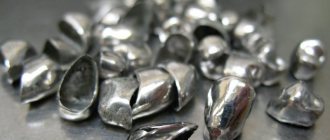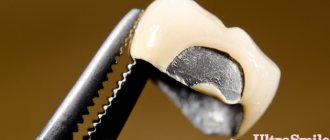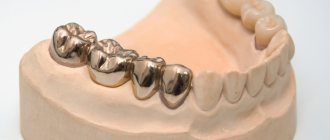From this article you will learn:
- what crowns are better to put on the front teeth,
- pros and cons of different crown options,
- How much does it cost to insert a front tooth?
When replacing anterior teeth, patients always place quite high demands on the aesthetics of dental crowns. The most important of them is that crowns on the front teeth should not be noticeable against the background of your own teeth, matching them in shape, color and transparency. The second important point is that crowns should not cause the gums to appear blue around them, because this will lead to its extremely aesthetically unsatisfactory appearance.
Today in dentistry there are only a few aesthetically acceptable options for prosthetics of anterior teeth. We are talking about prosthetics with metal-ceramics, zirconium crowns, as well as ceramic crowns “Emax” (glass-ceramics). Moreover, patients are equally often dissatisfied with both metal-ceramic and ceramic crowns, and below we will tell you why this happens and how to choose the most suitable option for you.
Metal-ceramic crowns for the front teeth: photo
The reasons for patient dissatisfaction lie not only in the low quality of work, but also in the initially incorrect choice of the type of crown, for example, not taking into account the level of transparency of the patient’s tooth enamel. The difficulty of choosing also lies in the fact that each of the types of crowns mentioned above (depending on the quality of the materials used and the manufacturing method used) can have either good or bad aesthetics. For example, let’s take economy-class metal ceramics made from budget ceramic mass “Duceram” (Germany).
Such metal ceramics can be found at an average price of 10,000 to 12,000 rubles. At the same time, the aesthetics of metal-ceramics made from budget ceramic mass will be very different from crowns that used more expensive ceramic mass, for example, “Noritake” (Japan), “Ivoclar” (Liechtenstein) or “Vita” (Germany). The average price for such metal ceramics in Moscow will be from 15,000 to 18,000 rubles. And if the metal ceramics were also made with the so-called “shoulder mass”, then you will have to add about 5,000 rubles to the price.
Important: we point out that within each type of crown there are numerous manufacturing options, the aesthetics of which will largely depend not only on the professionalism of the doctor and dental technician. Really good aesthetics will require more expensive materials and more labor-intensive manufacturing methods. But on the other hand, even choosing expensive ceramic crowns will not be an unconditional guarantee that you will get good aesthetics (since everything has its own nuances, which doctors often keep silent about).
Metal-plastic crowns
Such prostheses are called conditionally temporary crowns. A cost-effective prosthetics option that involves installing crowns with a metal base and a plastic coating. Traditionally, structures are made of nickel, cobalt, and chromium.
Despite the natural appearance and relatively good functionality, it is not worth wearing such prostheses for a long time: the product quickly loses its whiteness, slightly increases in size and needs to be replaced.
Among the undeniable advantages of metal plastic are its low cost and gentle effect on the enamel layer of the tooth. If the product is slightly deformed, it can be repaired directly in the patient’s mouth. Among the disadvantages of this choice, it is worth highlighting the low strength of the structure and the likelihood of developing allergies.
Smile zone: indications for installing crowns
When communicating and expressing emotions, the teeth in the frontal region are involuntarily exposed. Their condition is visible to others, and this can cause psychological discomfort. If you are not happy with the appearance of your front incisors, contact your dentist. Even in the most advanced cases, when teeth are severely damaged, it is not necessary to remove them. After a thorough diagnosis, the doctor may recommend restoring teeth with crowns. A cap-like structure is placed over the remaining part of the tooth and takes over its functions.
Metal-ceramic crowns
Practice shows that metal-ceramic crowns are deservedly considered the most popular. The base of the product is metal (cobalt, chromium, titanium, gold, etc.). To give the crown an aesthetic appearance, the metal base is covered with a ceramic layer and the elements are connected by exposure to high temperatures.
The popularity of metal ceramics in prosthetics is explained by its obvious advantages:
- Aesthetics. The material with which the crown frame is covered completely recreates the anatomical structure of the enamel;
- Sufficient strength. The products are quite durable due to the cast metal frame - they can withstand normal chewing loads and do not wear out. It is rare to see chipping of the enamel coating. In this case, repair of the prosthesis can be done in the patient’s mouth;
- Versatility. Crowns of this type are installed both on individual fragments of a row, and in the form of a dental bridge.
Since the ceramic layer is completely opaque, the prosthetic fragment (especially with a single restoration) can stand out against the background of natural teeth. Another disadvantage of metal-ceramic crowns is the need to grind the unit, after which it forever loses its original shape.
Possible complications after the procedure
Complications are rare after crown placement, but complications do occur. Most often this is a medical error or lack of professionalism. Therefore, the best prevention of complications is choosing a clinic with an excellent reputation. In addition, there are several diseases that do not depend on the doctor. They can be caused by medications, gastrointestinal diseases, and injuries.
Complications after crown installation
Prosthetic stomatitis (allergy)
Stomatitis, the cause of which is dentures, happens:
- allergic, this is a contact allergic inflammation, which often occurs after repeated prosthetics;
- toxic (occurs more often than allergic).
Prosthetic allergic stomatitis is a reaction to metal compounds and plastic. The more metal (a large number of bridges, crowns), the more likely an allergy. Moreover, this type can develop both immediately after installation and after 5-15 years of wearing crowns. Patients with gastrointestinal diseases and endocrine disorders are at risk. Typical complaints are swelling of the mucous membranes of the oral cavity and larynx, sometimes it is difficult to breathe, the tongue swells and does not fit in the mouth, but there are no ulcers familiar to ordinary stomatitis.
If a metal, metal-ceramic or metal-plastic crown is installed, a burning sensation of the tongue, drooling, and dry mouth are noted. If you are allergic to acrylates, granular bright red foci of inflammation appear on the mucous membrane of the palate, matching the shape and size of the prosthesis. In addition, skin reactions are noted - eczema, urticaria, dermatitis.
With toxic prosthetic stomatitis, the mucous membrane is damaged, and there is massive destruction of the epithelium of kidney, liver, intestinal cells, red blood cells, and nerve cells. Most often, poisoning is caused by stainless steel; if the crown (whole or base) is made of gold or a silver-palladium alloy, the disease occurs much less frequently.
This complication appears 1-7 days after installation. Characteristic symptoms of toxic denture stomatitis:
- burning tongue;
- drooling (hypersalivation);
- unpleasant feelings in the tongue, such as tingling, rawness (glossalgia);
- nervous disorders;
- gastrointestinal disorders.
Caries on supporting teeth
The ground teeth under the crown, if the nerve is removed, dry out over time. As soon as the seal is broken, bacteria and food particles penetrate under the denture and caries develops. That is why, even if part of the tooth and the root remain, it is better to build up the support than to remove the tooth along with the nerve.
Jaw trauma and hard food lead to a violation of the integrity of the crown and further development of caries underneath it. Development is promoted by poor oral care.
Galvanic syndrome
Saliva is a complex electrolyte, and the oral cavity is an electrochemical system in which:
- saliva (liquid phase), saturated with oxygen and carbon dioxide, acts as an electrolyte;
- teeth, dentures (solid phase) act as electrodes.
If there are metallic inclusions in the oral cavity that are not covered with ceramics (insulator), the potential of the electrode system increases sharply. There is a feeling of acidity and burning in the mouth. With a galvanic symptom, the functioning of the nervous system is disrupted, which leads to a general deterioration in the patient’s condition.
Metal crowns
These are the predecessors of all other types of dentures. This type of prosthesis is indicated for installation only on chewing teeth, since the structures are noticeable on the front teeth. Metal crowns are made of steel, titanium, platinum, and gold. Alloys containing cobalt, chromium, and silver are also in demand.
In laboratory conditions, stamped or cast products with spraying are prepared for patients. Standard structures take on the desired shape as work progresses. Individual production of the cap guarantees maximum adherence to the tissues, which eliminates rapid abrasion of the material and the spread of bacteria under the prosthesis.
Among the advantages of such products, it is worth noting their exceptional strength (due to the plasticity of the material, a crown made of this type of material does not crack and does not wear out for a long time). However, metal dentures are extremely unaesthetic, can cause allergies, and are difficult to fit on a tooth.
In addition, when using metal prosthetics, it is worth considering that crowns made from several types of metal cannot be used at once. If the patient already has a steel structure in his mouth, in the future he will have to fix crowns only from this material. Otherwise, the patient may develop galvanic syndrome, which is manifested by a burning sensation in the mouth and a “metallic” taste.
When is it necessary to remove installed crowns?
Removing crowns is an undesirable event, but under a number of circumstances it cannot be avoided. You will definitely have to remove the installed crown if:
1. An inflammatory process has occurred under the installed crown. Most often this happens due to mistakes made during canal filling. If the diagnosis reveals the presence of inflammation, the installed prosthesis will have to be removed, the tooth treated, and then the crown put on again;
2. Mistakes were made when making a dental crown. If the installed crown interferes with chewing, speaking, or does not adhere to the cervical part of the tooth with insufficient density, it is removed;
3. Installed crowns must also be removed during planned replacement of structures. Crowns made of any materials have specific terms
operation, after which the prosthesis should be replaced with a new design. The installed crown must be removed urgently if the prosthesis has been damaged during use.
Ceramic crowns for teeth
Metal-free crowns are deservedly recognized as the most aesthetic: they are extremely difficult to distinguish from natural teeth, even if the gum tissue becomes thinner, the prosthesis remains invisible and looks natural. In dentistry, several types of metal-free dental crowns are used:
- Porcelain or all-ceramic. They are made according to a personal impression from pressed material without adding other components.
- Mixed (zirconium dioxide and ceramics). They are stronger than the previous type of prosthesis, have high light transmittance and do not cause allergies.
- Mixed (aluminum oxide and ceramics). The designs are made of translucent hypoallergenic material, which is comfortable to wear and resistant to temperature changes.
All ceramic products are biologically compatible with mucous membranes and do not tend to cause allergic reactions. Other advantages of the designs include:
- light weight (a crown can be installed even on weakened teeth);
- immunity of ceramics to dyes;
- the need for minimal tooth grinding before ceramic prosthetics.
The disadvantages of this method of prosthetics include the relatively high cost of the products, as well as their fragility. Ceramic structures are not designed for significant chewing loads, which is why they are more often used for prosthetics of the upper incisors.
If you properly care for ceramic products, they will last from 10 to 15 years. At the same time, the prosthetic structure is not susceptible to caries and does not accumulate plaque.
Patient reviews
Dental problems started during pregnancy. Then there was a period of lactation, at the end of which I was left without two front teeth. At the clinic, an orthopedic dentist recommended making a metal-ceramic prosthesis. It didn’t suit me at all, they adjusted it four times, but to no avail. Then they replaced it with zirconium crowns. I've been using them successfully for three years now. I am no longer ashamed of my smile, but, on the contrary, proud of it.
Natalya, 34 years old
After caries treatment, I was left without one front tooth. The situation for a person who works with people is not the most pleasant. In my case, there was no doubt; I immediately chose prosthetics with zirconium crowns. In my opinion, this prosthesis is the most successful, although not cheap. Adaptation went quickly, no discomfort arose, and the smile remained the same; outwardly, the artificial incisor cannot be distinguished from the real one. I believe that only zirconium is suitable for restoring front teeth.
Alexander Sergeevich, 42 years old
Several years ago I had metal-ceramic crowns installed.
I was very pleased with the prosthesis, nothing interferes, my teeth are still in excellent condition. Many people were afraid that my gums would turn blue, but nothing like that happened in my case. I eat whatever I want, even hard apples, but no chips have arisen during this time. So I recommend this option to everyone I know. Angelina
Zirconium dioxide crowns
Zirconium crowns are prepared in laboratory conditions using high-precision computer equipment. Laser scanning allows for an accurate analysis of the dentition, after which a computer program models an accurate crown for the tooth. Optical data is transferred from the computer to a milling machine, which grinds the prosthesis from the workpiece.
These types of dental crowns are the most expensive. Their price is justified by a number of obvious advantages:
- Strength. Zirconium dioxide is as durable as natural tooth enamel. Even solid bridges can be made on the basis of this material;
- High aesthetics. The shade of zirconium dioxide can easily be matched to the color of the natural enamel layer;
- Biological compatibility. Zirconium dioxide is safe for human health. This type of prosthetics is not contraindicated for patients with metal allergies.
The products are recommended for installation by patients who have high demands on the appearance of structures and want their new teeth to be indistinguishable from natural elements.
What are the contraindications
Correcting crooked teeth with crowns will not work if you have serious malocclusions that affect the entire jaw and affect its functionality. In this case, you cannot do without orthodontic appliances or even their combination with surgery.
Important! Why can’t prosthetics be done with crowns if, for example, there are anomalies not in 1-2, but in a whole number of teeth? The restorations will be unstable and short-lived, and their functionality will also be very mediocre. Thus, due to improperly distributed load, structures can chip, break, and even move apart, forming gaps between the teeth.
Installation is contraindicated for patients with inflammation of periodontal tissues, leading to loosening of the row. For example, with periodontitis and periodontal disease. Also, prosthetics should not be performed on people with bruxism or neuropsychiatric disorders.
Gold crowns on teeth
Separately, it is worth noting the type of metal crowns - gold products. In dentistry, pure material is not used in the manufacture of dentures, since gold is a soft metal. Traditionally, an alloy with palladium and platinum is used. The structures fit well, do not irritate the mucous membrane, and do not lead to bleeding gums.
Very often, gold dentures are coated with a ceramic layer. Such products can even be placed on the front teeth: they retain the beneficial properties of the base material and look good.
Preparing for dental prosthetics
Many people do not like any dental procedures, and this is due to the fear of unbearable pain. You should not be afraid of dental prosthetics, since the most unpleasant thing you will encounter is tooth grinding and depulpation. And all procedures are carried out using local, good, strong anesthetics.
An important diagnostic point is x-ray examination to determine the number and size of roots.
Other stages of preparation include the improvement of neighboring teeth (removal of plaque, treatment of carious damage), which will serve as a support for the prosthesis. If the tooth is significantly damaged, they resort to extraction, treatment of the canals and their subsequent filling.
For prosthetic treatment of anterior teeth, as for any other manipulation, there are contraindications. They are divided into absolute and relative.
Absolute contraindications include:
- 3-4 stages of cancer;
- Conditions after chemotherapy;
- Immunodeficiency conditions;
- Severe somatic diseases in the stage of decompensated state;
Relative:
- Diabetes mellitus (especially type 1);
- Diseases of the heart and blood vessels, such as hypertension with crisis and angina pectoris;
- Smoking, alcoholism;
- Mental disorders;
- Pregnancy;
- Allergic reactions to dental medications and materials.
Temporary crowns on teeth
Since dental prosthetics requires time, the patient is often given temporary crowns. The patient wears the dentures until the permanent dentures are ready.
We are talking about inexpensive polymer, acrylic, and plastic crowns, which are designed to protect the prepared units from displacement and pathogens. In addition, they perfectly perform an aesthetic function, masking “holes” in the oral cavity.
Temporary crowns can be placed on natural teeth or on implants. Due to these structures, an even distribution of the chewing load is ensured, the risk of jawbone resorption is reduced, and the rate of adaptation to a permanent prosthesis is accelerated.
Ranking of dental crowns by nomination
| The most | |
| Aesthetic | Unaesthetic |
| Zirconium | Metal |
| Durable | Short-lived |
| Zirconium/Metal | Metal-plastic |
| Biologically compatible | Unsafe for the body |
| Zirconium/Ceramic/Metal-ceramic with gold-platinum alloy frame | Nickel-based metal-ceramic |
What dentures are best for the front teeth?
Since the teeth in the smile area are visible to others, high aesthetic demands are placed on prosthetics in this area. In this regard, it is better to install prostheses made of zirconium dioxide (aluminum oxide), metal ceramics or all-ceramic crowns on the front teeth.
Caps made of solid ceramics are put on the upper incisors; they look good and are not subject to heavy loads. Products are made from medical porcelain using injection molding.
The lower incisors and canines bear a significant load, so in this case, solid ceramics are replaced with zirconium dioxide. The durable frame is coated with a ceramic layer to create a reliable and attractive prosthesis for the front teeth.
In addition, zirconium dioxide is successfully used when installing dental bridges in the smile area.
Restoration with crowns is indicated in the following cases:
- aesthetic defects (chips, stains, cracks, diastemas, trema, curvature, etc.);
- single or complete destruction of teeth with preservation of the root;
- uneven gum line;
- bite pathology;
- pathological abrasion and discoloration of enamel;
- restoration of lost functions (biting, sharing food, diction).
The front incisors are not associated with the chewing function, so there are no strict requirements for the strength of the crowns. The doctor’s task is to recreate the anatomical shape and color of natural teeth, maintain their degree of transparency, and achieve a perfect match of sizes.
What is better to put on chewing teeth?
Since the chewing teeth bear the bulk of the load, the crowns on them must be strong. Most often, metal-ceramic crowns are placed in the lateral sections. Metal ceramics are durable and aesthetic, but require significant grinding of dental tissue.
Zirconium dioxide has proven itself to be excellent. Its strength is comparable to the strength of metal crowns; only zirconium prostheses, unlike metal ones, are very similar to natural teeth. Another advantage of this choice is the insignificant grinding of tooth enamel before prosthetics.
All-metal crowns on teeth are cheaper. They have a long service life and are resistant to corrosion. An even more significant disadvantage of such prostheses (in addition to the low level of aesthetics) is the risk of developing an allergy to the material.
Taking impressions.
The next stage after preparation is taking impressions of the tooth. Sometimes this stage is postponed to the next visit a few days after preparation. And that's why. During the preparation process, the doctor is often forced to touch the gum with the drill, injuring it and causing slight bleeding, especially if the tooth previously had subgingival carious cavities. Blood itself interferes with high-quality impression taking, because... Impression materials do not really like excess moisture and therefore the most important area - the ledge around the tooth - may not appear very accurately on the impression. In addition, in some people, the gums have a tendency to recede at the slightest trauma*. And if you take an impression immediately and use it to make a crown, then already at the moment of placing it (or, what is even more unpleasant, a little later) it may turn out that the gum has “run away” and the edge of the crown (especially a metal-ceramic one) sticks out unsightly above the gum.
This is what crowns can look like in a short time if you are not very careful with the gums. For the lateral teeth, “gum loss” may not be so critical, but in the anterior section it will definitely catch the eye of anyone...
The process of taking an impression looks like this: the doctor first places a special thread between the tooth and the gum with a tool in order to move the gum back and get a clear imprint of the formed ledge (sometimes, especially in the case of making metal-free crowns, the ledge is located so that there is no need to place the thread).
The thread that the doctor places in the groove between the gum and the tooth must “squeeze” the gum to the side so that the impression material can completely remove the ledge. Without it, in most cases, you cannot get a high-quality print. Any errors in the fit of the edge of the crown to the ledge will lead to the accumulation of plaque, bad breath and ultimately reduce the life of the crown and the tooth underneath...
The surface of the tooth being removed is thoroughly dried. Next, the doctor uses a special gun to squeeze out the liquid impression mass directly onto the tooth, while the assistant prepares a denser impression mass (like plasticine) and, using a special spoon, all this deliciousness is placed in the mouth for 2-3 minutes until it hardens completely. With a little effort, after a couple of minutes, the spoon with the resulting imprint is taken out into the light - the exact imprint of the tooth is ready!
Duration of operation of different types of crowns
The most short-lived structures are made of metal-plastic. Therefore, they are traditionally used as temporary crowns. The maximum service life of products is 5 years. According to patient reviews, over time the plastic coating deforms and darkens.
Metal-ceramics is a practical option that is installed on both the front and chewing teeth. Such structures last up to 10 years.
Crowns made of medical porcelain do not darken or fade and can last up to 10-15 years. Throughout this period, the product looks like a natural tooth.
Crowns made of zirconium dioxide are considered even more stable: their service life is 15-20 years.
Prostheses made from precious metal alloys and products made from nickel are also durable and can last up to 15 years.
The service life of different types of crowns depends not only on the material, but also on the accuracy of installation. There should be no voids or gaps under a well-fixed crown. Otherwise, food debris will accumulate under the product, which over time will lead to the development of an inflammatory prosthesis.
Manufacturing
Crowns are made using prepared plaster models. Metal, metal-ceramics and ceramics can be used as the manufactured material.
Manufacturing is quite labor-intensive and time-consuming, so while the dental technician is working on their creation, the patient is put on temporary plastic products. This way, the aesthetic appearance of the ground teeth is restored, and they are protected from external influences and infection. These dentures, in addition to protecting teeth, also allow them to be fully used when chewing.
How to properly care for crowns
The method of caring for crowns is practically no different from the principles of caring for natural teeth and involves:
- performing oral hygiene twice a day (not only the teeth, but also the tongue should be brushed);
- cleaning the spaces between teeth and the space under dentures. To ensure the proper level of hygiene, it is preferable to use an irrigator: a directed jet helps to quickly and painlessly clean the space under the product;
- nutrition correction - excluding too hard foods and temperature changes from the menu;
- monitoring the condition of the gums and areas where teeth meet crowns (this is where caries most often develops);
- using mouth rinses after each meal (special formulations can be replaced with plain water).
Dentists also advise periodically massaging the gums under the structure. Soft tissues undergo increased pressure, so it is important to stimulate blood circulation in these areas. The gums should be massaged with smooth circular movements clockwise and counterclockwise.
Alternative Treatment Options
Some doctors believe that straightening crooked teeth with crowns is not the best idea. The method is quite radical, and it is better to use it only in extreme cases, for example, when a tooth, in addition to curvature, has other defects, for example, it is severely damaged by dental disease or injury, and the question arises of how to extend its service life. Or if the patient has a disease such as systemic enamel hypoplasia.
If the choice in favor of crowns is based only on the fact that you do not want to wear braces, then we recommend considering more preferable options for correcting minor bite defects.
Composite restoration
This is the fastest and least expensive option when you want to correct 1-2 teeth with slight deformations located in the smile area. For example, if one of them is slightly offset in relation to the others, then the doctor can use a composite to increase its thickness so that it becomes symmetrical relative to its “neighbors”. In this case, the enamel is not ground or drilled with a bur, but only slightly sanded for better adhesion to the filling material.
The advantages of the method are that, even if you later decide to correct your bite with braces or other orthodontic devices, a specialist will easily remove the composite without consequences for hard tissues.
Veneers and Lumineers
Thin overlays, no more than 0.7 mm thick, can perfectly mask three, several crooked or “short” teeth in the smile area. Moreover, to install them, the doctor will not grind hard tissues from all sides; he will only need to dissect the outer frontal area. To fix the lumineers, it will be possible to get by with only minor grinding of the enamel, which is necessary to ensure that the linings stay firmly in place.
Installation of veneers and lumineers, like crowns, does not require several years of treatment. Overlays allow you to get a quick, comprehensive result and hide all external defects, from slight curvature to unsightly enamel color. Plus, they also perform a protective function, protecting sensitive tissues from the temperature of food and bacteria.
Aligners
Unlike braces, they are soft, transparent and removable; they can always be removed from the mouth for eating and hygiene procedures. During use, they are more comfortable - this is important information for those who are thinking about how crowns correct teeth only because they find wearing braces very inconvenient.
Another advantage of aligners: they, unlike crowns, veneers and lumineers, do not mask the defect, but treat it.
Trainers
Suitable for correcting minor malocclusion pathologies, including affecting the main causes of its occurrence. Namely, they help to eradicate bad functional habits that contributed to the development of deformity. For example, trainers will help the tongue take the correct position in the mouth and help form the correct type of breathing and swallowing. The devices are often used for children, but are sometimes recommended for adults as well.
How much does it cost to install a crown on a tooth?
The key criterion that determines the cost of prosthetics is the material used to make the prosthesis. If you arrange them from cheapest to most expensive, the list will look like this:
- metal-plastic;
- metal;
- gold;
- metal ceramics with ordinary metals;
- metal ceramics on a gold base;
- ceramics;
- zirconium dioxide.
In addition to the material, the price of the prosthesis is also influenced by the pricing policy of the clinic, the equipment used, and the qualifications of the attending physician. Some clinics manage to save money on prosthetics by installing crowns on several teeth at once.
It is impossible to accurately answer the question of which crown is best to install. The doctor makes the decision together with the patient. When choosing, emphasis is placed on clinical indications, characteristics of the patient’s jaw system, the state of oral health in general, the wishes and financial capabilities of the person.
Alternatives to a Dental Crown
Veneers are often preferred to crowns in the smile area. However, in this case, the back side of the elements should be more or less preserved.
Teeth can be restored using filling materials. This method can only be used if the destruction of the unit is not so global (less than half).
Judging by the reviews of doctors and patients, crowns are considered the optimal solution for significant damage to teeth, since they not only restore the functionality and aesthetics of a row, but also protect teeth from further destruction. An additional bonus of this type of prosthetics is the variability of materials and, accordingly, the cost of services.
Veneers or crowns: which is better?
You can restore your front teeth using veneers. Non-removable pads are attached to the turned elements. The procedure is much faster than prosthetics, but before making the final choice between veneers and crowns, consult your doctor. Durable ceramic onlays are classified as restoration methods in cosmetic (aesthetic) dentistry. Veneers that protect the surface of the tooth accurately imitate enamel, hiding all imperfections, but in case of significant damage and destruction they are not used. In these cases, crowns are installed.
